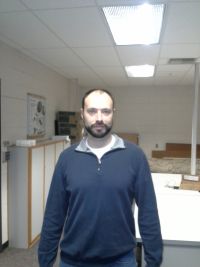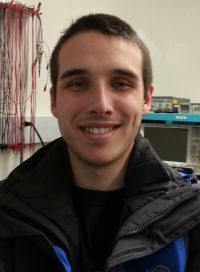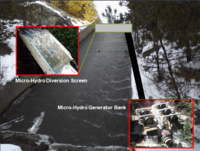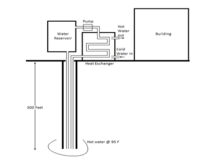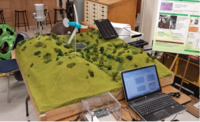YMCA Renewables
Project Green
Background
Horsethief Reservoir is located a few miles outside the city of Cascade, Idaho. The reservoir is almost two miles long and one mile wide. The YMCA Camp, located at the south end of the reservoir, includes 9 cabins, 5 yurts, and several other large facilities. The main focus of our project is The Barn, a dining facility that can seat up to 200 people. The camp is currently powered 100% by Idaho Power. Project Green hopes to change this by installing several solar panels across the camp as well as implementing a micro-hydro power station on the reservoir's spillway.
Sponsors
| Logo | Website |
|---|---|
|
[YMCA] | |
Team Members
| Picture | Bio | Discipline |
|---|---|---|
| Rishabh Jain:
Rishabh is pursuing his Maters in Electrical Engineering from the University of Idaho. His research interests are in Energy Optimization and Automation, with particular inclination to Renewables. In addition, he is involved with utilizing Machine Learning methods for Data learning and designing self-learning controllers. He has completed his Bachelors in Electrical Engineering from India. After graduating, he worked for a year with a Mineral exploration company, before coming to U of I. |
EE | |
| Isaac Cowger:
Originally from Weaver, Alabama, I am a senior in Electrical Engineering at the University of Idaho with an emphasis in Power Engineering. I received a bachelors degree in Math and Chemistry from Jacksonville State University, Alabama, in 2002 and served in the U.S. Army for 8 years following my college graduation. I worked with Southern Company in Birmingham, AL as a co-op student where I learned the utility side of electrical power and am currently employed as an Engineering Intern with Schweitzer Engineering Labs in Pullman, WA. |
EE | |
| Matt Baker:
Originally from Boise, Idaho, I am a senior in Electrical Engineering at the University of Idaho with a minor in mathematics. I plan to graduate in May of 2014 with an emphasis in power. I am working on the solar aspect of Project Green as well as doing budget analysis. After graduation, I hope to work in a field relevant to renewable energy. |
EE | |
| Michael West:
Born and raised in Idaho Falls, ID. I am a senior in Electrical Engineering at the University of Idaho with an emphasis in power engineering and a minor in mathematics. I plan to graduate in December of 2013. I am currently interning at the Idaho National Laboratory (INL) where I have been researching renewable energy technologies. After graduation, I will continue on to graduate school to obtain my masters degree in Electrical Engineering. |
EE | |
| Gage Gallagher:
Gage is studying electrical engineering and plans to graduate in December 2013 with an emphasis in power. He is working on the solar aspect of Project Green by drawing upon previous experience with the NASA Space Elevator Project at the University of Idaho. His interests include renewable energy and archery. |
EE |
Design Goals
Project Green's goal is to make a building at the YMCA Camp near Horsethief Reservoir in Cascade, Idaho completely energy efficient through the use of renewable energy sources. As many renewable resources can be seasonal, Team Green aims to discover methods of making those resources sustainable year-round. The main focus of this project will be The Barn, a dining facility that can seat up to 200 people. The Barn's main energy consumers are the heaters, kitchen utilities, and two 90kW water heaters. To make this building energy independent, 13 kW will have to be generated through the use of hydro, solar, biomass, and geothermal power.
Design Specifications
1. Meet The Barn's average energy usage of 10,290 kilowatt-hours per month.
2. Reduce The Barn's demand during peak usage hours to significantly reduce their energy bills.
3. Provide educational opportunities to the camp visitors.
Solar Power
1. Find most cost-effective solar array that will fit on less than 180 square meters of roof space.
2. Help reduce building's dependence on Idaho Power
Hydro Power
1. Design a micro-hydro system that works with the ~1100 Gal/min flow of the reservoir's spillway.
2. Help reduce peak demand.
Wind Power
1. Assess the Cascade valley to see if wind is a viable source of energy.
2. Install a wind turbine that visitors can interact with and learn from.
Biomass and Geothermal
1. Heat camp water with a 95F degree geothermal source.
2. Use biomass gasifier to reduce peak demand while also burning camp's tree trimming waste.
Project Learning
Renewable Sources
In order to reach any of our project goals, we first had to familiarize ourselves with all renewable sources of energy that held potential at the camp. We concluded that we needed to research hydro, solar, geothermal, biomass, and wind power.
Learn more: Solar Cell [[1]]
Learn more: Wind Turbine [[2]]
Learn more: Micro Hydro [[3]]
Learn more: Geothermal [[4]]
Learn more: Biomass Gasification [[5]]
Demand Charges
One of the major issues discovered was the camp's demand charges accounted for over 50% of their energy bills. “Demand” is the total amount of electricity being used by the customer at any given time. The demand usage, measured in kilowatts, is monitored over 15-minute periods. The customer is then charged for the highest 15-minute average recorded by the demand meter each month.
For example, if a person ran a 20 kW load continuously for 50 hours, their demand would be 20 kW and their usage would be 1,000 kWh (20 kW * 50 hours). Idaho Power has a demand charge of $6.00/kW in the summer so this 20 kW load would result in a demand charge of $120.00 (20 kW * $6). Assuming a billing rate of 7.7 cents per kWh, this 20 kW load used over a 50 hour timespan would result in an energy charge of $77.00. The total energy bill from running this 20 kW load for 50 hours would be $197.00.
In contrast, a 2 kW load running for 500 hours will result in a $12 demand charge. The total energy used will be 1,000 kWh and the energy charge will be $77.00. The total energy bill from this 2 kW load for 500 hours would be $89.00. In comparison, this is less than half of what the previous example’s bill was for the same number of kilowatt-hours consumed.
Concept Development
Solar Power
The Barn’s roof area was calculated to be around 180 square meters, which is enough space to hold up to 100 solar panels and produce approximately 50 kWh per day. According to solar-estimate.org, the size of the solar system required to produce 50 kWh per day in Cascade, Idaho ranges between 10.58 kW and 15.88 kW and takes up around 130 square meters of roof space. When built, the roof was designed for future mounting of solar panels. As a result, the roof has been oriented towards the South and is built to hold the weight of solar panels. It is oriented at a 35 degree angle which is the optimal angle for optimized year round power production at the geographic location.
Hydro Power
The spillway, located on the southeast edge of Horsethief Reservoir, was measured for both flow and head during a visit to the reservoir. We found that the spillway has 30 feet of head and has a flow of ~1100 gallons-per-minute.
Wind Power
Based on models collected from various wind power companies, it is believed that wind may be lacking in the area. However, a wind turbine would serve as an excellent educational tool for camp participants. By using a small wind turbine for demonstration, the option of teaching how wind energy is harnessed and even why it might not be a viable option at the camp would be largely beneficial.
Opportunities for teaching camp participants about wind energy include but are not limited to the following:
- Demonstration of conversions between potential, kinetic, and electrical energy
- Real time data display of power generation
- How wind turbines function
- Discuss why the area is not a viable option for wind generation (economically)
Geothermal
As a result of the hot water spot found when drilling in 2006, a geothermal well near The Barn (if required) can serve as a local resource to aid in producing hot water during peak hours when the kitchen and showers are in use.
Biomass
Biomass is one of the abundant resources available to the YMCA camp. The 400-acre camp is constantly maintaining its forests and collecting a large amount of tree trimmings. These trimmings can be used as a source of fuel with a biomass gasifier.
While using biomass to generate electricity is a very viable option, using it to heat water instead will address some major problems relevant to the building’s load profile and lower the camp’s demand charges. These heaters are tank-less and consume large amount of electricity during shower-hours at specific day times. This is a prominent cause of the high demand charges of the building.
Terrain Model
Due to insufficient funding, the ideas presented were not able to be installed this year. However, in order to demonstrate the validity of this system, a micro-scale model was designed. This design is an educational tool that can be used to reach out to children participating in the YMCA camp. It provides both visual and hand’s on components that exhibit functionality for hydro, solar, and wind generation.
To begin, a rough, approximate terrain was constructed out of fiber glass. The terrain was modeled based off of a topographical map and was then made to look like the environment surrounding the YMCA camp. This provides an “overhead” view of the region
The tools installed on the terrain model are used to provide insight on several of the power generation ideas presented. A solar panel was mounted onto the terrain model in order to demonstrate the idea of harnessing the sun’s natural energy. Even though wind power was not dependable for generation, a small turbine was installed onto the terrain model for demonstration. A water tower was also installed to demonstrate how power is generated through hydro. The geothermal and biofuels were not installed on the model as it would be difficult to safely operate such components and the “hands on” experience would be dissolved. These three components are then integrated together to an Arduino micro-controller providing digital display of power data from both solar and wind generation. The system also used a hydro sensor to display changes in water levels which is then interpreted to increasing or decreasing power generation. All data is easily displayed in Microsoft Excel. Another visual tool that was added consists of several LED displays. Based on certain amounts of power generation, the LEDs light up accordingly. The goal of this is to use the power generated by these renewable sources and show students some of the advantages and disadvantages of these technologies.
Conclusion
Since the proposed renewable resources were put in place by the end of our senior project period, future project groups will need to oversee the implementation of the design ideas. We have estimated the costs of these systems and have located the potential areas to place them in, but we have not determined how they will connect to the grid. A future group will need to work with Idaho Power and the camp to determine how to do this. They will also need to determine whether or not they will install the systems themselves or hire contractors to do it.
Developing a control system that addresses the building’s demand can also serve as a future senior project. The students will need to analyze the building’s demand more in depth by monitoring exactly when the demand spikes, what contributes to it, and what kind of systems will handle it efficiently. A system that monitors the building’s usage and automatically starts the biomass gasifier or some other local generator when the demand goes beyond the 20 kW level needs to be developed.
This project may also have the potential to turn into a project for the entire community of Cascade, ID. The local people may see the potentials that are available and picture a renewable energies power plant for the entire community. This may open up possibilities for future senior design students at the University of Idaho to create a sustainable system to aid in utilities costs and economic hardships.




